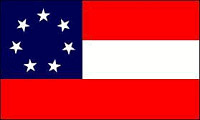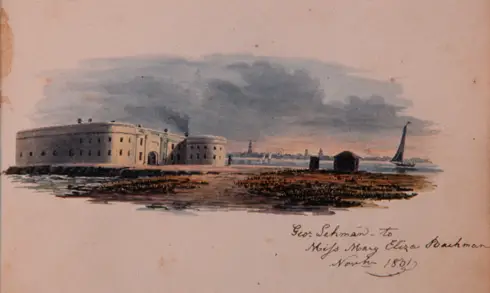Colonial Wars |
American Wars |
Link To This Page — Contact Us —
Castle Pinckney Prisoner of War Camp
Search, View, Print Union & Confederate Civil War Prisoner of War Records, 1861-1865

Confederate 1861-1862
Charleston, South Carolina
Castle Pinckney became one of the war's first prisoner-of-war camps and one of the few that was not a death camp. Named for Revolutionary War hero Gen. Charles C. Pickney, this fort was built late in 1809 to replace the log fort that a hurricane destroyed in 1804. The prison was one of the few Confederate prisons outside of Richmond, Virginia at the beginning of the war.
During June 1861, Charleston city officials were notified to prepare the prison for the incarceration of Union prisoners. The first prisoners, a group of 156 men, arrived at the prison on September 18, when the prison renovations were complete.
The prison was located on the southern tip of a small island called Shute's Folly in Charleston Harbor. The island lied near the conjunction of the Cooper and Ashley Rivers less than a mile off the coast of Charleston, and about 3.5 miles northwest of Fort Moultrie and Fort Sumter.
The fort was horseshoe shaped and described as an elliptical form built of brick. It had 2 tiers of guns, having a good magazine and enough quarters to hold 200 officers and enlisted men. The diameter of the fort was 170-feet, with the entrance on the northern side. Located on either side of the fort's entrance were the quarters for the officer's and the enlisted men. Its casemates were bricked up and converted to individual sleeping quarters for prisoners. The walls were lined by 3-tiered bunks.
Not long after the opening of the prison, it was found that it was found entirely too small and too inadequate as a permanent prison. On October 13, all of the prisoners were moved out of the prison and sent to the Charleston City Jail. After the great fire in Charleston on December 11, more than 300 prisoners were sent back to Castle Pickney to be held until their was space available in other prisons. By the first part of 1862, the prison was turned into a defensive fortification.
The first guard duty was the Charleston Zouave Cadets, a group of about 40 elite, young Charlestonians who operated their facility most effectively.
 |
LIFE & CONDITIONS:
After the battle of the 1st Manassas/Bull Run, some of the first Union prisoners of the Civil War were sent to Castle Pickney. Prisoners were from the 69th and 79th New York Regiment, the 8th Michigan Infantry, and the 11th Fire Zouaves, the last recruited from New York City's Fire Department. The prisoners were an exceptionally intelligent lot, and the Charleston Zouaves, while maintaining strict discipline, treated them as such. Both guards and prisoners treated one another with civility and respect. The Confederate soldiers maintained strict discipline and ensured the prisoners maintained clean and sanitary conditions. The association of captives and keepers was remarkably agreeable. The prison remained peaceful, and the prisoners kept their quarters in excellent condition.
When Capt. Chichester engaged a photographer to take pictures of both the Charleston Zouaves and the prisoners, the 11th New York Zouaves had theirs taken in front of their quarters, over which they had placed a big sign, " Hotel de Zouave".
The prisoners did volunteer work of various kinds, shared the same food as their guards, and taught the Charleston Zouaves the preferred army method of softening Hardtack. They created the "Castle Pickney Brotherhood", which established a pattern for living, including rules for cleanliness and provisions foir entertainment, and the Charleston Zouaves helped in the brotherhood's activities.
The prison was peaceful, and there is no record of a prisoner having escaped from Castle Pinckney. At night, the prisoners were locked up in their quarters and during the daytime, they were allowed to wander in and out of the quarters and inside the fort's interior parade grounds.
